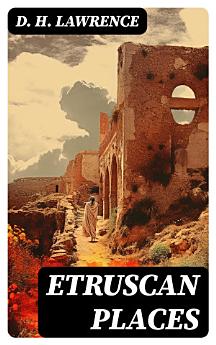Etruscan Places
2023. g. nov. · DigiCat
E-grāmata
110
Lappuses
family_home
Piemērota
info
reportAtsauksmes un vērtējumi nav pārbaudīti. Uzzināt vairāk
Par šo e-grāmatu
In "Etruscan Places," D. H. Lawrence embarks on a profound journey through Italy's ancient Etruscan landscapes, art, and culture, juxtaposing his introspective prose with vivid descriptions that evoke both the physical and spiritual essence of the locations. The text showcases Lawrence's characteristic lyrical style, blending travelogue, philosophy, and a deep appreciation for the natural world, as he reflects on the relationship between humanity and its environment. Written during the early 20th century, against a backdrop of burgeoning modernism and a retreat from industrialization, the book serves as both a personal pilgrimage and a critique of contemporary society's disconnection from its roots. D.H. Lawrence, an English novelist and poet, was deeply influenced by his own life experiences, including his tumultuous relationships and fascination with the primal aspects of human existence. His travels through Europe, particularly in Italy, offered him an escape from the constraints of English society and provided fertile ground for his explorations of art, culture, and identity. Lawrence's deep engagement with the Etruscan civilization reflects his broader quest for authentic experience amid modern malaise. "Etruscan Places" is a compelling exploration for readers invested in the intersections of art, history, and personal identity. As Lawrence captures the essence of the Etruscan spirit, he invites readers to contemplate the enduring connections between past and present, making this book a rewarding read for both admirers of literary travel writing and those seeking to understand the intricacies of cultural legacy.
Par autoru
David Herbert Lawrence, known as D. H. Lawrence (1885–1930), was an influential English writer recognized for his contributions to literature as a novelist, poet, playwright, essayist, literary critic, and painter. Though often best known for his novels, which include 'Sons and Lovers' (1913), 'Women in Love' (1920), and the controversial 'Lady Chatterley's Lover' (1928), Lawrence's work is notable for its exploration of human consciousness, nature, and sexuality. His writing reflects a deep preoccupation with the dehumanizing effects of modernity and industrialization, advocating for a more profound connection with the primal forces of life. In 'Etruscan Places' (1932), a travel book published posthumously, Lawrence indulges his fascination with ancient civilizations, reflecting on the art, religion, and culture of the Etruscan people. This work demonstrates his versatility as a writer and his enduring quest to understand and articulate the human experience in its most authentic forms. Known for his lyrical prose and the intensity of his emotional and philosophical assertions, Lawrence was also a critical voice in challenging the social norms of his time, which often brought him into conflict with censorship authorities. His literary style is characterized by a unique blend of psychological insight, mythical elements, and a profound sense of place, asserting his legacy as one of the 20th century's foremost literary figures.
Novērtējiet šo e-grāmatu
Izsakiet savu viedokli!
Informācija lasīšanai
Viedtālruņi un planšetdatori
Instalējiet lietotni Google Play grāmatas Android ierīcēm un iPad planšetdatoriem/iPhone tālruņiem. Lietotne tiks automātiski sinhronizēta ar jūsu kontu un ļaus lasīt saturu tiešsaistē vai bezsaistē neatkarīgi no jūsu atrašanās vietas.
Klēpjdatori un galddatori
Varat klausīties pakalpojumā Google Play iegādātās audiogrāmatas, izmantojot datora tīmekļa pārlūkprogrammu.
E-lasītāji un citas ierīces
Lai lasītu grāmatas tādās elektroniskās tintes ierīcēs kā Kobo e-lasītāji, nepieciešams lejupielādēt failu un pārsūtīt to uz savu ierīci. Izpildiet palīdzības centrā sniegtos detalizētos norādījumus, lai pārsūtītu failus uz atbalstītiem e-lasītājiem.







